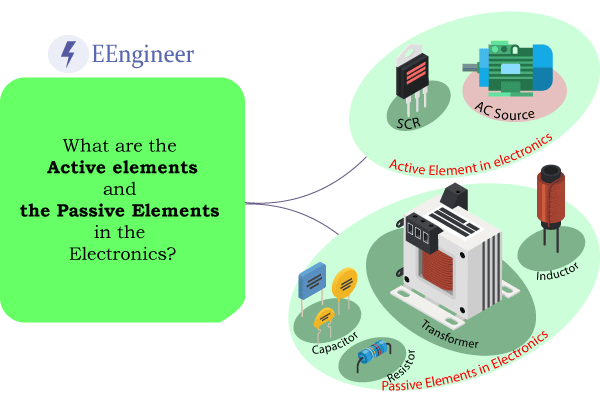Generally, The elements that are capable to Generate or rectifying, or amplifying a signal are known as Active elements otherwise Passive elements.
Table of Contents
What is an Active Element?
An active element in a circuit supplies energy to others. Further, you can say that an active element restricts the flow of current in a single direction. Such types of elements can generate a signal or rectify a signal or Amplify a signal easily.
This is known that examples are mostly silicon devices like Transistor, SCR, Diac and Triac, and Op-amp. Of course, Voltage sources and current sources are the major examples.
Voltage Source
Generally, a voltage source which is AC or DC is always an Active element. Because it always supplies the power and never absorbs.
Current Source
Generally, a current source is a constant source of power that always delivers power without being dependent on others. that is why the current source is also an active element.
Further, all the semiconductor elements or components are always active. Because they can Rectify or Amplify the signal according to the applications.
What is a Passive Element?
An Electrical / Electronics Component that is always responsible for consuming energy is called a Passive element. Such elements can’t generate a signal or rectify a signal or Amplify a signal. The Examples are Resistors, Inductors, transformers, and capacitors. Lastly, Passive Elements are dependent elements on the supply. without supply they are dead.
Resistor
The Resistor is considered to be the passive element in the electrical network. Because a passive element in a circuit can’t generate, rectify, or amplify a signal. The Resistor always dissipates energy in the form of heat.
Capacitor
When a capacitor is subjected to or connected to the active source. Thus the capacitor acts as a passive element. When AC is a source to the capacitor, it absorbs energy in the positive half cycle. But releases in the negative cycle. Due to this absorption, this element is called a passive element.
Inductor
Further, consider the Inductor as a load to the AC or DC supply. It also stores energy in the form of the magnetic field in the half-cycle and the other half-cycle releases energy. That is why the Inductor is also a Passive element.
A transformer is a Passive element
While many people think that it should be an active element. Because the secondary of the transformer acts as a source. But by the good knowledge, if you see, Transformer absorbs from primary too. Further, it is nothing without an active source connected. Hence transformer is a passive element.
Comparison between active and passive elements (components)
Moreover, here are some beautiful differences between them.
| S.No. | Active Elements | Passive Elements |
|---|---|---|
| 1 | Supplies energy. | Always absorbs energy. |
| 2 | Without this circuit is called dead. | Without this circuit may not exist. |
| 3 | Can rectify, amplify, or likewise generate a signal. | Can’t rectify, amplify, or likewise generate a signal. |
| 4 | Needs the power to operate. | Don’t need the power to operate. |
Practical Active and Passive Elements (components) Examples
These are some practical examples.
| S.No. | Active Elements | Passive Elements |
|---|---|---|
| 1 | Voltage Source | Resistor (R) |
| 2 | Current Source | Inductor (L) |
| 3 | Transistor | Capacitor (C) |
| 4 | Silicon Controlled Rectifier (SCR) | Lastly, Transformer |
| 5 | Diac & Triac | |
| 6 | Lastly, Op-amp (Operational Amplifier) |


Comments are closed.